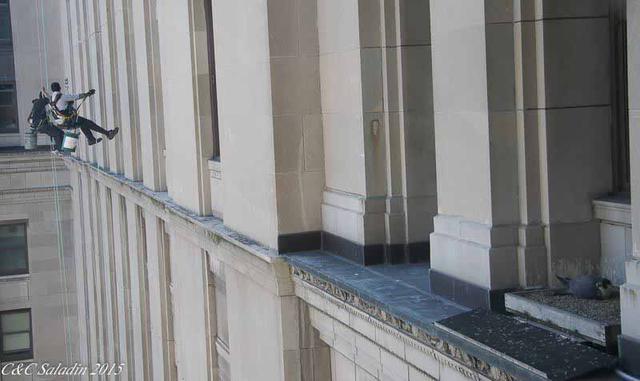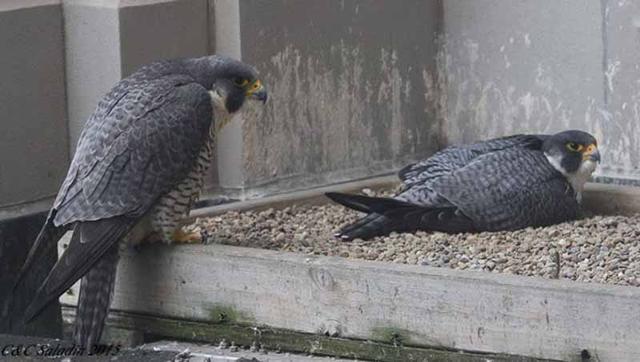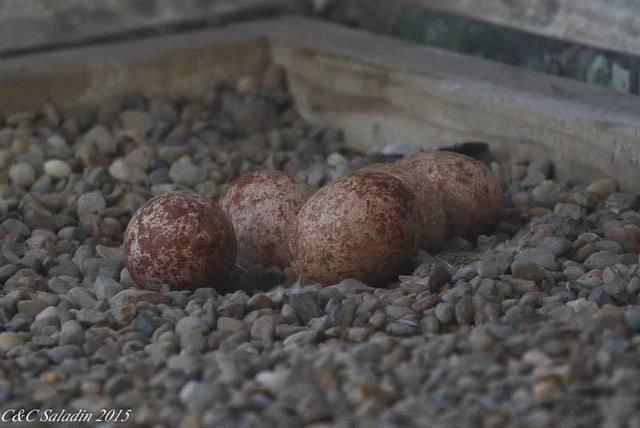FALCON FLASH
Dateline: Cleveland, Ohio
April 30, 2015
Click here to read what happened earlier
Remember when Newton was scared of volunteer nest monitor, Mrs. Saladin, peeking at her from behind a window? Well, Newton didn’t mind the window washers at all. Mrs. Saladin watched as the window washers swung by and reports, “….. she rose up and re-situated on the eggs once and took a few looks upward, yet she barely reacted to the men swinging on ropes suspended relatively close to her nest. In fact, she took a nap while they were nearby”.
We are hoping Newton and Boomer’s eggs will be hatching soon. The fourth egg was laid on April 7th and the fifth egg was laid on April 9th. Incubation usually lasts 33 to 35 days from the date the last egg, or the second last, was laid. However, this year might be different because there are five eggs and incubation might have started after the third egg was laid on April 4th. When do you think the first egg will hatch? Right now you can look for signs that point towards hatching. You may notice that the parents seem to be listening to their eggs. Are the little chicks peeping inside?
The window washers rappelled down the building and stopped to wash windows near her. They are 12 stories up on a skyscraper!
Mrs. Saladin adds, “Despite their legendary defensiveness, peregrines have such a reputation as adaptable animals that early falconers and researchers suggested that at some point they could become domesticated”. Falconry is an ancient sport, practiced around the world for thousands of Years, in which falcons partner with people to hunt. Here’s an interesting note: just inside Newton and Boomer’s nest ledge is the Greenbrier Hotel. One of its rooms has wallpaper that shows an ancient Tibetan scene depicting the sport of falconry.
This week, Newton got two surprise visitors at the nest ledge…….
Last year, Newton had only one chick hatch. With five eggs, we hope the chances are better this year. Keep your eyes and browser set to: http://www.falconcam-cmnh.org/news.php
To learn more about falconry go to:
Our thanks to the Cleveland Museum of Natural History for sponsoring the FalconCams.
The videos, pictures and wonderful commentary are courtesy of volunteer peregrine nest monitors, Mr. and Mrs. Saladin.
Here is a picture showing the windows inside the skyscraper where Mrs. Saladin watches the nest.
Mrs. S tells us, “the falcons nest behind the middle window that is covered and sealed so that they are not disturbed (until bolts are removed for the banding)”. Newton is getting so comfortable with Mrs. Saladin watching her that Mrs. S is able to open a nearby window to watch and take pictures.
Recently, Mrs. Saladin witnessed a “shift change” at the nest. Boomer was on the eggs and Newton came back from her break to take over incubation duties. Mrs. S comments, “Shift changes are fascinating, as they show the personalities and the nonverbal "language" of the pair”. She notes that different pairs interact differently. Sometimes the tiercels (males) are more dominant, but some are more intimidated by
their large female partner. The following picture shows Newton coming back after her break, ready to take over incubation duties.
Here are 2 video clips showing Newton’s arrival and the shift change:
If you are able to see the clips, what observations can you make about the interaction between Newton and Boomer during shift change?
As hatch time nears, you can watch the FalconCam for clues that an egg is hatching. In the last few days before the hatch, the female often does not want to leave the nest and chases the male away if he offers to take over incubation. It's hard to see on the FalconCam, but you can look for tiny cracks on an egg that is about to hatch and then a "pip", which is a small hole that the young bird inside the egg has made with its special “egg tooth”. According to Mr. Harvey Webster, Director of Wildlife Resources at the Cleveland Museum of Natural History, “It generally takes 24-36 hours between the onset of the pip and actual hatching. The parents do not assist in the hatching process”. Former volunteer nest monitor Mr. Scott Wright, adds: "Look for an eggshell, but do it quick as the female will often eat the eggshell,
and move the shell about, often picking it up with her beak. Yes, eggs can hatch out during the night. Hairline cracks will indicate that a hatch is under way".
Click here to read what happened next








